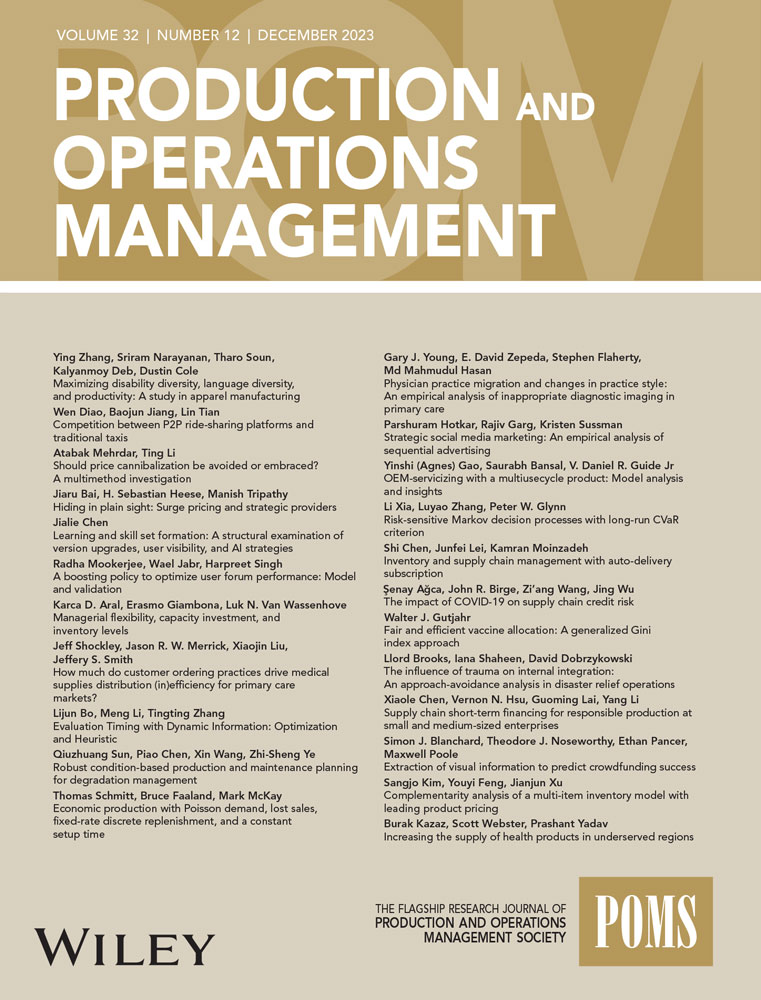When should grocery stores adopt time‐based pricing? impact of competition and negative congestion externality
IF 5.1
3区 管理学
Q1 ENGINEERING, MANUFACTURING
引用次数: 0
Abstract
Consumers dread shopping during peak hours, and the Covid-19 pandemic has created additional safety concerns about overcrowding in addition to long waiting times. In view of consumer's congestion aversion, should competitive brick-and-mortar grocery stores charge higher prices during congested peak hours to smooth demand? To examine "whether and when” stores should adopt intraday time-based pricing under competition, we examine a 2-stage dynamic duopoly game. At the beginning of each stage, each store can make an irreversible decision to adopt time-based pricing by setting the peak-hour and normal-hour prices. We also endogenize consumer's shopping decisions (i.e., when and which store to shop) by incorporating the issue of negative congestion externality. Our equilibrium analysis reveals that time-based pricing is always beneficial for the stores, and both stores would adopt it eventually in equilibrium. As such, only two equilibria can sustain: either both firms adopt time-based pricing immediately in stage 1, or only one firm adopts in stage 1 while the other postpones its adoption until stage 2. Interestingly, due to the competitive dynamics, it is less likely for both firms to adopt immediately when consumers are more averse to congestion. Moreover, although the adoption of time-based pricing leads to differentiated price competition, it can "soften” price competition, causing both peak-hour and normal-hour prices to rise above the status quo equilibrium uniform prices. We find that time-based pricing can always induce demand smoothing and reduce congestion. Although time-based pricing creates value for the stores (through higher prices), it offers no benefit to consumers. © 2023 Production and Operations Management Society.杂货店什么时候应该采用基于时间的定价?竞争的影响与负拥堵外部性
消费者害怕在高峰时段购物,新冠肺炎疫情除了漫长的等待时间外,还引发了对过度拥挤的额外安全担忧。鉴于消费者对拥堵的厌恶,有竞争力的实体杂货店是否应该在拥堵的高峰时段收取更高的价格来满足需求?为了检验竞争条件下商店是否以及何时应该采用日内时间定价,我们检验了一个两阶段的动态双寡头博弈。在每个阶段开始时,每个商店都可以通过设定高峰时段和正常时段的价格来做出不可逆的决定,采用时间定价。我们还内生了消费者的购物决策(即何时以及在哪家商店购物)通过纳入负拥堵外部性问题。我们的均衡分析表明,基于时间的定价对商店总是有利的,并且两家商店最终都会在均衡中采用它。因此,只有两种均衡可以维持:要么两个公司在第一阶段立即采用基于时间的定价,要么只有一个公司在第一阶段采用,而另一个公司将其采用推迟到第二阶段。有趣的是,由于竞争动态,当消费者更反对拥堵时,两家公司都不太可能立即采用。此外,尽管采用基于时间的定价导致了差异化的价格竞争,它可以“软化”价格竞争,导致高峰时段和正常时段的价格都高于现状均衡的统一价格。我们发现,基于时间的定价总是可以促进需求平滑并减少拥堵。尽管基于时间的价格(通过更高的价格)为商店创造价值,它对消费者没有任何好处。©2023生产与运营管理协会。
本文章由计算机程序翻译,如有差异,请以英文原文为准。
求助全文
约1分钟内获得全文
求助全文
来源期刊

Production and Operations Management
管理科学-工程:制造
CiteScore
7.50
自引率
16.00%
发文量
278
审稿时长
24 months
期刊介绍:
The mission of Production and Operations Management is to serve as the flagship research journal in operations management in manufacturing and services. The journal publishes scientific research into the problems, interest, and concerns of managers who manage product and process design, operations, and supply chains. It covers all topics in product and process design, operations, and supply chain management and welcomes papers using any research paradigm.
 求助内容:
求助内容: 应助结果提醒方式:
应助结果提醒方式:


